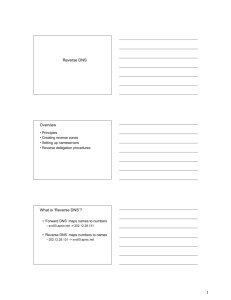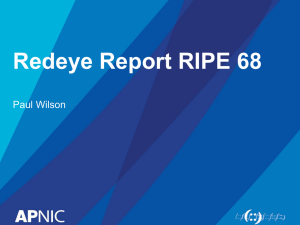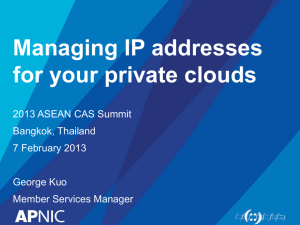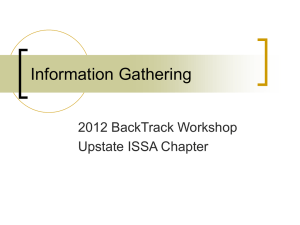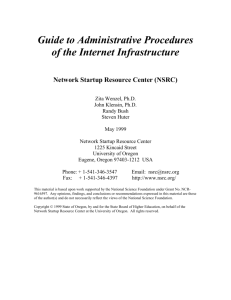DNS Concepts
advertisement
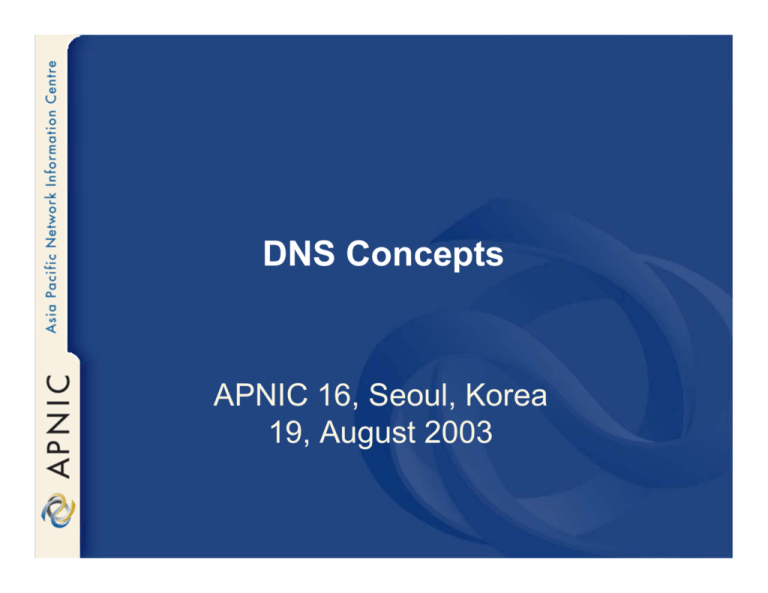
DNS Concepts
APNIC 16, Seoul, Korea
19, August 2003
Acknowledgements
•
•
•
•
Bill Manning
Olaf M. Kolkman
Ed Lewis
Joe Abley
Overview
•
•
•
•
•
Introduction to the DNS system
DNS features & concepts
Writing zone files
Reverse DNS
APNIC procedures
Purpose of naming
• Addresses are used to locate objects
• Names are easier to remember than
numbers
• You would like to get to the address or
other objects using a name
• DNS provides a mapping from names to
resources of several types
Names and addresses in general
• An address is how you get to an endpoint
– Typically, hierarchical (for scaling):
• 950 Charter Street, Redwood City CA, 94063
• 204.152.187.11, +1-650-381-6003
• A “name” is how an endpoint is referenced
– Typically, no structurally significant hierarchy
• “David”, “Tokyo”, “itu.int”
Naming History
• 1970’s ARPANET
– Host.txt maintained by the SRI-NIC
– pulled from a single machine
– Problems
• traffic and load
• Name collisions
• Consistency
• DNS created in 1983 by Paul Mockapetris (RFCs
1034 and 1035), modified, updated, and enhanced
by a myriad of subsequent RFCs
DNS
• A lookup mechanism for translating objects
into other objects
• A globally distributed, loosely coherent,
scalable, reliable, dynamic database
• Comprised of three components
A “name space”
Servers making that name space available
Resolvers (clients) which query the servers
about the name space
DNS Features: Global Distribution
• Data is maintained locally, but
retrievable globally
– No single computer has all DNS data
• DNS lookups can be performed by
any device
• Remote DNS data is locally cachable
to improve performance
DNS Features: Loose Coherency
• The database is always internally
consistent
– Each version of a subset of the database (a
zone) has a serial number
• The serial number is incremented on each database
change
• Changes to the master copy of the
database are replicated according to timing
set by the zone administrator
• Cached data expires according to timeout
set by zone administrator
DNS Features: Scalability
• No limit to the size of the database
– One server has over 20,000,000 names
• Not a particularly good idea
• No limit to the number of queries
– 24,000 queries per second handled
easily
• Queries distributed among masters,
slaves, and caches
DNS Features: Reliability
• Data is replicated
– Data from master is copied to multiple
slaves
• Clients can query
– Master server
– Any of the copies at slave servers
• Clients will typically query local
caches
DNS Features: Dynamicity
• Database can be updated dynamically
– Add/delete/modify of any record
• Modification of the master database
triggers replication
– Only master can be dynamically updated
• Creates a single point of failure
Concept: DNS Names
• The namespace needs to be made
hierarchical to be able to scale.
• The idea is to name objects based on
– location (within country, set of
organizations, set of companies, etc)
– unit within that location (company within
set of company, etc)
– object within unit (name of person in
company)
Concept: DNS Names
contd.
• How names appear in the DNS
– Fully Qualified Domain Name (FQDN)
•
WWW.APNIC.NET.
– labels separated by dots
• DNS provides a mapping from FQDNs
to resources of several types
• Names are used as a key when
fetching data in the DNS
Concept: DNS Names contd.
• Domain names can be mapped to a tree
• New branches at the ‘dots’
Root DNS
dots
www
net
edu
apnic
isi
whois
whois
ftp
com
Concept: Resource Records
• The DNS maps names into data using
Resource Records.
Resource Record
www.apnic.net.
…
A 10.10.10.2
Address Resource
• More detail later
Concept: Domains
• Domains are “namespaces”
• Everything below .com is in the com
domain
• Everything below apnic.net is in the
apnic.net domain and in the net
domain
Concept: Domains
•
net edu com
•
•
google
apnic isisun tislabs
moon
www whois
www
ftp
ws2 ws1
•
•
•
net
domain
•
apnic.net
domain
com domain
Delegation
• Administrators can create subdomains to group hosts
– According to geography, organizational affiliation or any other
criterion
• An administrator of a domain can delegate
responsibility for managing a subdomain to someone
else
– But this isn’t required
• The parent domain retains links to the delegated
subdomain
– The parent domain “remembers” who it delegated the
subdomain to
Concept: Zones and Delegations
• Zones are “administrative spaces”
• Zone administrators are responsible
for portion of a domain’s name space
• Authority is delegated from a parent
and to a child
Concept: Zones and Delegations
net edu com
•
google
apnic isi sun tislabs
moon
www whois
www
ftp
ws2 ws1
•
•
•
whois.apnic.net
zone
•
apnic.net
zone
•
net zone
•
net
domain
Concept: Name Servers
• Name servers answer ‘DNS’ questions
• Several types of name servers
– Authoritative servers
• master (primary)
• slave (secondary)
– (Caching) recursive servers
• also caching forwarders
– Mixture of functionality
Concept: Name Servers contd.
• Authoritative name server
– Give authoritative answers for one or
more zones
– The master server normally loads the
data from a zone file
– A slave server normally replicates the
data from the master via a zone transfer
Concept: Name Servers contd.
• Authoritative
name server
slave
master
slave
Concept: Name Servers contd.
• Recursive server
– Do the actual lookups; ask questions to
the DNS on behalf of the clients
– Answers are obtained from authoritative
servers but the answers forwarded to the
clients are marked as not authoritative
– Answers are stored for future reference
in the cache
Concept: Resolvers
• Resolvers ask the questions to the
DNS system on behalf of the
application
• Normally implemented in a system
library (e.g, libc)
Concept: Resolving process & Cache
Question:
www.apnic.net A
www.apnic.net A ?
Resolver
192.168.5.10
Caching
forwarder
(recursive)
www.apnic.net A ?
root-server
Ask net server @ X.gtld-servers.net (+ glue)
www.apnic.net A ?
gtld-server
Ask apnic server @ ns.apnic.net (+ glue)
Add to cache
www.apnic.net A ?
192.168.5.10
apnic-server
Concept: Resource Records
• Resource records consist of it’s name, it’s
TTL, it’s class, it’s type and it’s RDATA
• TTL is a timing parameter
• IN class is widest used
• There are multiple types of RR records
• Everything behind the type identifier is
called rdata
www.apnic.net.
Label
3600
IN
ttl
A
10.10.10.2
type
class
rdata
Example: RRs in a zone file
apnic.net. 7200 IN
admin.apnic.net.
SOA
ns.apnic.net.
(
2001061501
; Serial
43200 ; Refresh 12 hours
14400 ; Retry 4 hours
345600 ; Expire 4 days
7200 ; Negative cache 2
hours
)
apnic.net.
apnic.net.
7200
7200
IN
IN
NS
NS
ns.apnic.net.
ns.eu.net.
whois.apnic.net.
3600
IN
A
193.0.1.162
IN
A
193.0.3.25
host25.apnic.net.
Label
2600
ttl
class
type
rdata
Resource Record: SOA and NS
• The SOA and NS records are used to
provide information about the DNS
itself
• The NS indicates where information
about a given zone can be found
• The SOA record provides information
about the start of authority, i.e. the top
of the zone, also called the APEX
Resource Record: SOA
Contact address
Master server
net. 3600 IN SOA
Version
A.GTLD-SERVERS.net.
nstld.verisign-grs.com. (
2002021301
; serial
30M
; refresh
15M
; retry
1W
; expiry
1D )
; neg.answ.ttl
number
Timing parameter
Concept: TTL and other Timers
• TTL is a timer used in caches
– An indication for how long the data may
be reused
– Data that is expected to be ‘stable’ can
have high TTLs
• SOA timers are used for maintaining
consistency between primary and
secondary servers
Places where DNS data lives
• Changes do not propagate instantly
Might take up to refresh
to get data from master
Slave
Not going to net if TTL>0
Cache server
Upload of zone
data is local
policy
Master
Registry DB
Slave server
To remember...
• Multiple authoritative servers to distribute
load and risk:
– Put your name servers apart from each other
• Caches to reduce load to authoritative
servers and reduce response times
• SOA timers and TTL need to be tuned to
needs of zone. Stable data: higher numbers
What have we learned so far
• We learned about the architectures of
– resolvers,
– caching forwarders,
– authoritative servers,
– timing parameters
• We continue writing a zone file
Writing a zone file
• Zone file is written by the zone administrator
• Zone file is read by the master server and it’s
content is replicated to slave servers
• What is in the zone file will end up in the
database
• Because of timing issues it might take some
time before the data is actually visible at the
client side
First attempt
• The ‘header’ of the zone file
– Start with a SOA record
– Include authoritative name servers and, if
needed, glue
– Add other information
• Add other RRs
• Delegate to other zones
The SOA record
apnic.net. 3600 IN SOA ns.apnic.net.
admin\.email.apnic.net. (
2002021301
1h
30M
1W
3600 )
Comments
;
;
;
;
;
serial
refresh
retry
expiry
neg. answ. ttl
• admin.email@apnic.net Ã
admin\.email.apnic.net
• Serial number: 32bit circular arithmetic
– People often use date format
– To be increased after editing
• The timers above qualify as reasonable
Authoritative NS records and related
A records
netsa.org.
netsa.org.
IN.netsa.org.
LK.netsa.org.
3600
3600
3600
3600
IN
IN
IN
IN
NS IN.netsa.org.
NS LK.netsa.org.
A 193.0.0.4
A 193.0.0.202
• NS record for all the authoritative servers
– They need to carry the zone at the moment you
publish
• A records only for “in-zone” name servers
– Delegating NS records might have glue
associated
Other data in the zone
localhost.netsa.org. 3600
IN.netsa.org.
4500
www.netsa.org.
3600
IN
IN
IN
A
A
CNAME
127.0.0.1
193.0.0.4
IN.netsa.org.
• Add all the other data to your zone file
• Some notes on notation
– Note the fully qualified domain name
including trailing dot
– Note TTL and CLASS
Zone file format short cuts
nice formatting
netsa.org.
3600 IN SOA IN.netsa.org.
admin\.email.netsa.org. (
2002021301
1h
30M
1W
3600 )
;
;
;
;
;
serial
refresh
retry
expiry
neg. answ. Ttl
netsa.org.
netsa.org.
netsa.org.
netsa.org.
3600
3600
3600
3600
IN
IN
IN
IN
NS
NS
MX
MX
IN.netsa.org.
LK.netsa.org.
50
mailhost.netsa.org.
150 mailhost2.netsa.org.
netsa.org.
IN.netsa.org.
LK.netsa.org.
localhost.netsa.org.
3600
4500
3600
3600
IN
IN
IN
IN
TXT
A
A
A
“Demonstration and test zone”
193.0.0.4
193.0.0.202
127.0.0.1
IN.netsa.org.
www.netsa.org.
3600 IN A
193.0.0.4
3600 IN CNAME IN.netsa.org.
Zone file format short cuts: repeating
last name
netsa.org.
3600 IN SOA IN.netsa.org.
admin\.email.netsa.org. (
2002021301
; serial
1h
; refresh
30M
; retry
1W
; expiry
3600 )
; neg. answ. Ttl
3600 IN NS
IN.netsa.org.
3600 IN NS
LK.netsa.org.
3600 IN MX
50
mailhost.netsa.org.
3600 IN MX
150 mailhost2.netsa.org.
IN.netsa.org.
LK.netsa.org.
3600 IN TXT
3600 IN A
3600 IN A
“Demonstration and test zone”
193.0.0.4
193.0.0.202
localhost.netsa.org.
4500 IN A
127.0.0.1
IN.netsa.org.
www.netsa.org.
3600 IN A
193.0.0.4
3600 IN CNAME IN.netsa.org.
Zone file format short cuts: default
TTL
$TTL
3600 ; Default TTL directive
netsa.org.
IN SOA IN.netsa.org. admin\.email.netsa.org. (
2002021301
; serial
1h
; refresh
30M
; retry
1W
; expiry
3600 )
; neg. answ. Ttl
IN NS
IN.netsa.org.
IN NS
LK.netsa.org.
IN MX
50 mailhost.netsa.org.
IN MX
150 mailhost2.netsa.org.
IN.netsa.org.
LK.netsa.org.
IN TXT “Demonstration and test zone”
IN A
193.0.0.4
IN A
193.0.0.202
localhost.netsa.org.
IN A
IN.netsa.org.
www.netsa.org.
127.0.0.1
4500 IN A
193.0.0.4
IN CNAME IN.netsa.org.
Zone file format short cuts: ORIGIN
$TTL
3600 ; Default TTL directive
$ORIGIN netsa.org.
@
IN SOA IN admin\.email.netsa.org. (
2002021301
; serial
1h
; refresh
30M
; retry
1W
; expiry
3600 )
; neg. answ. Ttl
IN NS
IN
IN NS
LK
IN MX
50 mailhost
IN MX
150 mailhost2
IN
LK
IN TXT
IN A
IN A
localhost
IN A
IN
www
“Demonstration and test zone”
193.0.0.4
193.0.0.202
127.0.0.1
4500 IN A
193.0.0.4
IN CNAME IN
Delegating a zone (becoming a
parent)
• Delegate authority for a sub domain to
another party (splitting of
whois.apnic.net from apnic.net)
•
net edu com
•
•
•
•
•
whois.apnic.net
zone
•
apnic.net
zone
google
apnic isi sun tislabs
moon
www whois
www
ftp
ws2 ws1
Concept: Glue
• Delegation is done by adding NS records:
whois.apnic.net.
whois.apnic.net.
NS ns1.whois.apnic.net.
NS ns2.whois.apnic.net.
• How to get to ns1 and ns2… We need the
addresses
• Add glue records to so that resolvers can
reach ns1 and ns2
ns1.whois.apnic.net. A 10.0.0.1
ns2.whois.apnic.net. A 10.0.0.2
Concept: Glue
contd.
• Glue is ‘non-authoritative’ data
• Don’t include glue for servers that are
not in sub zones
whois.apnic.net.
NS
whois.apnic.net.
NS
whois.apnic.net.
NS
ns1.whois.apnic.net. A
ns1.whois.apnic.net.
ns2.apnic.net.
ns1.apnic.net.
10.0.0.1
Only this record needs glue
Delegating whois.apnic.net. from
apnic.net.
whois.apnic.net
• Setup minimum
two servers
• Create zone file
with NS records
• Add all
whois.apnic.net
data
apnic.net
• Add NS records
and glue
• Make sure there is
no other data from
the whois.apnic.net.
zone in the zone file
Reverse DNS
Overview
•
•
•
•
•
•
Principles
Creating reverse zones
Setting up nameservers
Reverse delegation procedures
IPv6 reverse delegations
Current status
What is ‘Reverse DNS’?
• ‘Forward DNS’ maps names to numbers
– svc00.apnic.net -> 202.12.28.131
• ‘Reverse DNS’ maps numbers to names
– 202.12.28.131 -> svc00.apnic.net
Reverse DNS - why bother?
• Service denial
• That only allow access when fully reverse
delegated eg. anonymous ftp
• Diagnostics
• Assisting in trace routes etc
• Registration
• Responsibility as a member and Local IR
In-addr.arpa
• Hierarchy of IP addresses
– Uses ‘in-addr.arpa’ domain
• INverse ADDRess
• IP addresses:
– Less specific to More specific
• 210.56.14.1
• Domain names:
– More specific to Less specific
• delhi.vsnl.net.in
– Reversed in in-addr.arpa hierarchy
• 14.56.210.in-addr.arpa
Principles
• Delegate maintenance of the reverse
DNS to the custodian of the address
block
• Address allocation is hierarchical
– LIRs/ISPs -> Customers -> End users
Principles – DNS tree
- Mapping numbers to names - ‘reverse DNS’
Root DNS
net
edu
com
au
in-addr
apnic
whois
whois
arpa
RIR
202
202
ISP
64
64
Customer
22
22
203
210
211..
22 .64.202 .in-addr .arpa
Creating reverse zones
• Same as creating a forward zone file
– SOA and initial NS records are the same
as normal zone
– Main difference
• need to create additional PTR records
• Can use BIND or other DNS software
to create and manage reverse zones
– Details can be different
Creating reverse zones - contd
• Files involved
– Zone files
• Forward zone file
– e.g. db.domain.net
• Reverse zone file
– e.g. db.192.168.254
– Config files
• <named.conf>
– Other
• Hints files etc.
– Root.hints
Start of Authority (SOA) record
ns.test-domain.net.
ns.test-domain.net.
admin.test-domain.net
<domain.name.>
CLASS
<mailbox.domain.name> (
SOA
<hostname.domain.name.>
<serial-number>
<refresh>
<retry>
<expire>
<negative-caching> )
253.253.192.in-addr.arpa.
253.253.192.in-addr.arpa.
IN
IN
(<2003033101>
(<2003033101>
<10800>
<10800>
<3600>
<3600>
<604800>
<604800>
<10800>))
<10800>
Nameserver (NS) records
• Declares the nameservers that serve
a given zone
<domain.name.> IN NS <hostname.domain.name.>
ns.apnic.net.
ns.apnic.net.
Pointer (PTR) records
• Create pointer (PTR) records for each IP
address
131.28.12.202.in-addr.arpa. IN PTR svc00.apnic.net.
or
131
IN
PTR
svc00.apnic.net.
A reverse zone example
$ORIGIN 1.168.192.in-addr.arpa.
@
3600 IN SOA test.company.org. (
sys\.admin.company.org.
2002021301
; serial
1h
; refresh
30M
; retry
1W
; expiry
3600 )
; neg. answ. ttl
1
NS
NS
ns.company.org.
Note
ns2.company.org.
dots
PTR
gw.company.org.
router.company.org.
trailing
2
PTR
ns.company.org.
;auto generate: 65 PTR host65.company.org
$GENERATE 65-127 $ PTR host$.company.org.
What we covered so far
•
•
•
•
•
Why Reverse DNS ?
The DNS tree ?
Files involved
Essential Resource Records
How to create reverse zones
Setting up the primary nameserver
• Add an entry specifying the primary server to the
named.conf file
zone "<domain-name>" in {
type master;
file "<path-name>"; };
• <domain-name>
– Ex: 28.12.202.in-addr.arpa.
• <type master>
– Define the name server as the primary
• <path-name>
– location of the file that contains the zone records
Setting up the secondary nameserver
• Add an entry specifying the primary server to the
named.conf file
zone "<domain-name>" in {
type slave;
file "<path-name>";
Masters { <IP address> ; }; };
• <type slave> defines the name server as the
secondary
• <ip address> is the IP address of the primary name
server
• <domain-name> is same as before
• <path-name> is where the back-up file is
Reverse delegation requirements
• /24 Delegations
• Address blocks should be assigned/allocated
• At least two name servers
• /16 Delegations
• Same as /24 delegations
• APNIC delegates entire zone to member
• Recommend APNIC secondary zone
• < /24 Delegations
• Read “classless in-addr.arpa delegation”
RFC
2317
APNIC & ISPs responsibilities
• APNIC
– Manage reverse delegations of address block
distributed by APNIC
– Process members requests for reverse
delegations of network allocations
• ISPs
– Be familiar with APNIC procedures
– Ensure that addresses are reverse-mapped
– Maintain nameservers for allocations
• Minimise pollution of DNS
Subdomains of in-addr.arpa domain
• Subnetting on an Octet Boundary
– Similar to delegating subdomains of
forward-mapping domains
• Mapping problems
– In IPv4 the mapping is done on 8 bit
boundaries (class full), address allocation
is classless
– Zone administration does not always
overlap address administration
Subdomains of in-addr.arpa domain
• Example: an organisation given a /16
– 192.168.0.0/16 (one zone file and further
delegations to downstreams)
– Zone file should have:
0.168.192.in-addr.arpa.
0.168.192.in-addr.arpa.
1.168.192.in-addr.arpa.
1.168.192.in-addr.arpa.
2.168.192.in-addr.arpa.
2.168.192.in-addr.arpa.
:
:
NS ns1.organisation0.com.
NS ns2.organisation0.com.
NS ns1.organisation1.com.
NS ns2.organisation1.com.
NS ns1.organisation2.com.
NS ns2.organisation2.com.
Subdomains of in-addr.arpa domain
• Example: an organisation given a /19
– 192.168.0.0/19 (a lot of zone files!) –
have to do it per /24)
– Zone files
0.168.192.in-addr.arpa.
1.168.192.in-addr.arpa.
2.168.192.in-addr.arpa.
:
:
31.168.192.in-addr.arpa.
Subdomains of in-addr.arpa domain
• Example: case of a /24 subnetted with
the mask 255.255.255.192
– In-addr zone – 254.253.192.in-addr.arpa
– Subnets
•
•
•
•
192.253.254.0/26
192.253.254.64/26
192.253.254.128/26
192.253.254.192/26
– If different organisations has to manage
the reverse-mapping for each subnet
• Solution to follow…
Classless in-addr
• CNAME records for each of the domain
names in the zone
– Pointing to domain names in the new
subdomains
1.254.253.192.in-addr.arpa.
2.254.253.192.in-addr.arpa.
:
0-63.254.253.192.in-addr.arpa.
0-63.254.253.192.in-addr.arpa.
65.254.253.192.in-addr.arpa.
66.254.253.192.in-addr.arpa.
:
64-127.254.253.192.in-addr.arpa.
64-127.254.253.192.in-addr.arpa.
129.254.253.192.in-addr.arpa.
130.254.253.192.in-addr.arpa.
:
128-191.254.253.192.in-addr.arpa.
128-191.254.253.192.in-addr.arpa.
:
:
IN CNAME 1.0-63.254.253.192.in-addr.arpa.
IN CNAME 2.0-63.254.253.192.in-addr.arpa.
86400 IN NS
86400 IN NS
IN CNAME
IN CNAME
ns1.organisation1.com.
ns2.organisation1.com.
65.64-127.254.253.192.in-addr.arpa.
66.64-127.254.253.192.in-addr.arpa.
86400 IN NS
86400 IN NS
IN CNAME
IN CNAME
86400 IN NS
86400 IN NS
ns1.organisation2.com.
ns2.organisation2.com.
129.128-191.254.253.192.in-addr.arpa.
130.128-191.254.253.192.in-addr.arpa.
ns1.organisation3.com.
ns2.organisation3.com.
Classless in-addr
• Using $GENERATE (db.192.253.254 file)
$GENERATE 1-63 $ IN CNAME
0-63.254.253.192.in-addr.arpa.
0-63.254.253.192.in-addr.arpa.
$.0-63.254.253.192.in-addr.arpa.
86400 IN NS
86400 IN NS
ns1.organisation1.com.
ns2.organisation1.com.
$GENERATE 65-127 $ IN CNAME
$.64-127.254.253.192.in-addr.arpa.
64-127.254.253.192.in-addr.arpa.
64-127.254.253.192.in-addr.arpa.
86400 IN NS
86400 IN NS
$GENERATE 129-191 $ IN CNAME
$.128-191.254.253.192.in-addr.arpa.
128-191.254.253.192.in-addr.arpa.
128-191.254.253.192.in-addr.arpa.
:
:
86400 IN NS
86400 IN NS
ns1.organisation2.com.
ns2.organisation2.com.
ns1.organisation3.com.
ns2.organisation3.com.
Classless in-addr
• Now, the zone data file for 0-63.254.253.192.inaddr.arpa can contain just PTR records for IP
addresses 192.253.254.1 through 192.253.154.63
$TTL 1d
@
IN SOA
(
IN
IN
1 IN
2 IN
3 IN
ns1.organisation1.com. Root.ns1.organisation1.com.
NS
NS
1
; Serial
3h
; Refresh
1h
; Retry
1w
; Expire
1h )
; Negative caching TTL
ns1.organisation1.com.
ns2.organisation1.com.
PTR
PTR
PTR
org1-name1.organisation1.com.
org1-name2.organisation1.com.
org1-name3.organisation1.com.
APNIC reverse delegation
procedures
• Upon allocation, member is asked if they want /24 place
holder domain objects with member maintainer
– Gives member direct control
• Standard APNIC database object,
– can be updated through online form or via email.
• Nameserver/domain set up verified before being
submitted to the database.
• Protection by maintainer object
– (current auths: CRYPT-PW, PGP).
• Zone file updated 2-hourly
APNIC reverse delegation
procedures
• Complete the documentation
• http://www.apnic.net/db/domain.html
• On-line form interface
– Real time feedback
– Gives errors, warnings in zone
configuration
• serial number of zone consistent across
nameservers
• nameservers listed in zone consistent
– Uses database ‘domain’ object
Reverse delegation request form
Create Domain Object
Domain Object
*Domain:
*Descr:
Country:
*Admin-c:
An admin
- cmust be someone physically located at the site of the network.
Reverse delegation request form
*Nserver:
dns.vsnl.net.in
giasbm01.vsnl.net.in
Remarks:
Notify:
*Mnt-by:
This email address will be notified
by the APNIC database when this
object changes
MAINT-WF-EX
*Password:
You must supply a password for one of the maintainers listed in this field
Mnt-lower:
This stops ad-hoc additions
beneath this zone.
Online errors (also via email)
Please wait while your request is processed.
Parsing and validating your submission …
Errors encountered
Your update request was unable to be completed due to the following errors. Please
correct them and try again. If the error is temporary in nature, correct the error and
‘Reload’ this page (possibly this frame).
• *ERROR*. SOA on “ns.apnic.net” does not match SOA on “svc00.apnic.net”. All nservers
must respond with the same SOA.
• *ERROR*. NS RR for ns.telstra.net found on svc00.apnic.net but not in supplied template.
• *ERROR*. NS RR for ns.telstra.net found on svc00.apnic.net but not in supplied template.
• *ERROR*. NS RR for ns.telstra.net found on ns.apnic.net but not in supplied template.
• *ERROR*. NS RR for ns.telstra.net found on ns.apnic.net but not in supplied template.
• *ERROR*. cross-check of listed NS RR failed.
Request submission error
Verifying your authorisation ….
Your maintainer uses the ‘CRYPT-PW’ or ‘NONE’ authorisation schema. Attempting to submit your
request directly to the database.
Update results
Connection closed.
% Rights restricted by copyright. See
http://www.apnic.net/db/dbcopyright.html
Update FAILED: [domain] 174.202.in-addr-arpa
Update failed
domain:
174.202.in-addr.arpa
descr:
in-addr.arpa zone for 202.174/16
admin-c: DNS3-AP
tech-c:
DNS3-AP
zone-c:
DNS3-AP
nserver: ns.apnic.net
Authorisation
nserver: svc00.apnic.net
mnt-by:
MAINT-AP-DNS-DEFAULT
failed
changed: dns-admin@apnic.net 20000215
source:
APNIC
*ERROR*: authorisation failed, request forwarded to maintainer
Processing completed
APNIC reverse delegation
procedures - Evaluation
• Parser checks for
– ‘whois’ database
• IP address range is assigned or allocated
• Must be in APNIC database
– Maintainer object
• Mandatory field of domain object
– Nic-handles
• zone-c, tech-c, admin-c
APNIC reverse delegation
procedures - Evaluation
• Nameserver checks
– Minimum 2 nameservers required
– Check serial versions of zone files are
the same
– Check NS records in zones are the
same as listed on form
– Nameserver can resolve itself, forward
and reverse
Successful update
Please wait while your request is processed.
Parsing and validating your submission …
Warnings generated
•
Verifying your authorisation ….
Your maintainer uses the ‘CRYPT-PW’ or ‘NONE’ authorisation schema. Attempting
to submit your request directly to the database.
Update results
Connection closed.
% Rights restricted by copyright. See http://www.apnic.net/db/dbcopyright.html
Update OK: [domain] 174.202.in-addr.arpa
Update ok!
Processing completed.
Whois domain object
ReverseZone
Zone
Reverse
domain:
descr:
admin-c:
tech-c:
zone-c:
nserver:
nserver:
nserver:
nserver:
nserver:
mnt-by:
mnt-lower:
changed:
source:
28.12.202.in-addr.arpa
in-addr.arpa zone for 28.12.202.in-addr.arpa
DNS3-AP
Contacts
Contacts
DNS3-AP
DNS3-AP
ns.telstra.net
rs.arin.net
Name
ns.myapnic.net
Name
Servers
svc00.apnic.net
Servers
ns.apnic.net
MAINT-APNIC-AP
MAINT-DNS-AP
inaddr@apnic.net 19990810
Maintainers
Maintainers
APNIC
(protection)
(protection)
Use of maintainer object
• Domain objects protected by maintainers
• hierarchical protection using “mnt-lower”
• Bootstrap period
– ‘MAINT-AP-DNS-DEFAULT’ for all objects
imported by APNIC from existing zone files
• Changing delegations requires valid maintainer
• Maintainer creation & authorisation is manual
– Turnaround time 2 days
– /24 place holder objects created upon allocation
gives members direct control
• No need to contact APNIC when changing nservers
Delegation process summary
Step 1
no
request parsed
OK?
on-line feedback given
yes
Step 2
no
authorisation
OK?
yes
request forwarded to
APNIC for manual
processing
Delegation by APNIC
Step 3
update APNIC
database
notify upd-to
contact for
maintainer object
zone files reloaded
Every 2 hrs, 24hrs a day on everyday
Reverse DNS Troubleshooting Guide:
http://www.apnic.net/services/help/rd/troubleshooting.html
What we covered so far
•
•
•
•
•
Why Reverse DNS ?
The DNS tree
Files involved
Essential Resource Records
How to create reverse zones
•
•
•
•
Setting up nameservers – config files
APNIC reverse delegation requirements
Classless in-addr.arpa
APNIC reverse delegation procedures
IPv6 representation in the DNS
• Forward lookup support: Multiple RR
records for name to number
– AAAA (Similar to A RR for IPv4 )
– A6 without chaining (prefix length set to 0 )
• Reverse lookup support:
– Reverse nibble format for zone ip6.int
– Reverse nibble format for zone ip6.arpa
IPv6 forward and reverse mappings
• Existing A record will not accommodate
IPv6’s 128 bit addresses
• BIND expects an A record’s recordspecific data to be a 32-bit address (in
dotted-octet format)
• An address record
– AAAA (RFC 1886)
• A reverse-mapping domain
– Ip6.int (now replaced by ip6.arpa)
The reverse DNS tree – with IPv6
Root DNS
net
edu
com
int
in-addr
apnic
whois
whois
arpa
RIR
202
202
ISP
64
64
Customer
22
22
203
210
IP6
IP6
IPv6 Addresses
IPv6 forward lookups
• Multiple addresses possible for any
given name
– Ex: in a multi-homed situation
• Can assign A records and AAAA
records to a given name/domain
• Can also assign separate domains for
IPv6 and IPv4
Sample forward lookup file
;; domain.edu
$TTL
86400
@
IN
SOA
ns1.domain.edu. root.domain.edu. (
2002093000
; serial - YYYYMMDDXX
21600
; refresh - 6 hours
1200
; retry - 20 minutes
3600000
; expire - long time
86400)
; minimum TTL - 24 hours
;; Nameservers
IN
NS
ns1.domain.edu.
IN
NS
ns2.domain.edu.
;; Hosts with just A records
host1
IN
A
1.0.0.1
;; Hosts with both A and AAAA records
host2
IN
A
1.0.0.2
IN
AAAA
2001:468:100::2
IPv6 reverse lookups
• IETF decided to restandardize IPv6 PTR RRs
– They will be found in the IP6.ARPA namespace
rather than under the IP6.INT namespace
• The ip6.int domains has been deprecated, but
some hosts still use them
– Supported for backwards compatiblity
• Now using ip6.arpa for reverse
IPv6 reverse lookups - AAAA and
ip6.arpa
• Address record four times longer than A
– Quad A ( AAAA )
• AAAA record is a parallel to the IPv4 A
record
• It specifies the entire address in a single
record
IPv6 reverse lookups - AAAA and
ip6.arpa
• Example
Ipv6-host
IN
AAAA
4321:0:1:2:3:4:567:89ab
–Each level of subdomain
• Represents 4 bits
4.3.2.1.0.0.0.0.0.0.0.1.0.0.0.2.0.0.0.3.0.0.0.4.0.5.6.7.8.9.a.b
b.a.9.8.7.6.5.0.4.0.0.0.3.0.0.0.2.0.0.0.1.0.0.0.0.0.0.0.1.2.3.4.ip6.arpa.
IPv6 reverse lookups - PTR records
• Similar to the in-addr.arpa
b.a.9.8.7.6.5.0.4.0.0.0.3.0.0.0.2.0.0.0.1.0.0.0.0.0.0.0.1.2.3.4.ip6.arpa.
IN
PTR
test.ip6.example.com.
• Example: reverse name lookup for a host
with address 3ffe:8050:201:1860:42::1
$ORIGIN 0.6.8.1.1.0.2.0.0.5.0.8.e.f.f.3.ip6.arpa.
1.0.0.0.0.0.0.0.0.0.0.0.2.4.0.0
14400
IN PTR host.example.com.
Sample reverse lookup file
;; 0.0.0.0.0.0.1.0.8.6.4.0.1.0.0.2.rev
;; These are reverses for 2001:468:100::/64)
;; File can be used for both ip6.arpa and ip6.int.
$TTL
86400
@
IN
SOA
ns1.domain.edu. root.domain.edu. (
2002093000
; serial - YYYYMMDDXX
21600
; refresh - 6 hours
1200
; retry - 20 minutes
3600000
; expire - long time
86400)
; minimum TTL - 24 hours
;; Nameservers
IN
NS
ns1.domain.edu.
IN
NS
ns2.domain.edu.
1.0.0.0.0.0.0.0.0.0.0.0.0.0.0.0
IN
PTR
host1.ip6.domain.edu
2.0.0.0.0.0.0.0.0.0.0.0.0.0.0.0
IN
PTR
host2.domain.edu
;;
;; Can delegate to other nameservers in the usual way
;;
Sample configuration file
// named.conf
zone “domain.edu” {
type master;
file “master/domain.edu”;
}
zone “0.0.0.0.0.0.1.0.8.6.4.0.1.0.0.2.ip6.int" {
type master;
file "master/0.0.0.0.0.0.1.0.8.6.4.0.1.0.0.2.rev";
};
zone “0.0.0.0.0.0.1.0.8.6.4.0.1.0.0.2.ip6.arpa" {
type master;
file "master/0.0.0.0.0.0.1.0.8.6.4.0.1.0.0.2.rev";
};
Reverse delegation for existing
/35 holders
• Reverse tree has 4bit ‘boundary’
– /35 allocation needs two /36 delegations
FP |
/35 allocations|
|3 |
/32 |
|--|----------------------------|--|----……
00100000000000010000001000111000000?
------------ 35 bits -------------2
0
0
1: 0
2
3
8
0/35
Can be 1 or 0
• Delegation for two /36
0.8.3.2.0.1.0.0.2.ip6.arpa
1.8.3.2.0.1.0.0.2.ip6.arpa
Current Status – IPv6 in DNS
• A6 and Bit label specifications has
been made experimental
– RFC3363
• IETF standardized 2 different formats
– AAAA and A6
– Confusions on which format to deploy
– More than one choice will lead to delays
in the deployment of IPv6
AAAA Vs A6 – IETF WG consensus
• AAAA records are preferable at the
moment for production deployment of
IPv6
• A6 records have interesting properties
that need to be better understood
before deployment
• It is not known if the benefits of A6
outweigh the costs and risks
What we covered so far
•
•
•
•
Why Reverse DNS ?
The DNS tree
Files and essential Resource Records
How to create reverse zones
•
•
•
•
Setting up nameservers – config files
APNIC reverse delegation requirements
Classless in-addr.arpa
APNIC reverse delegation procedures
•
•
•
•
IPv6 representation in the DNS
IPv6 forward and reverse mappings
AAAA and A6 records
Current status
Questions ?
References
• DNS and BIND by Paul Albitz & Cricket Liu
– O’Reilly
• Request Forms
• http://www.apnic.net/db/revdel.html
• http://www.apnic.net/db/domain.html
• Classless Delegations
• http://ftp.apnic.net/ietf/rfc/rfc2000/rfc2317.txt
• Common DNS configuration errors
• http://ftp.apnic.net/ietf/rfc/rfc1000/rfc1537.txt
• Domain name structure and
delegation
• http://ftp.apnic.net/ietf/rfc/rfc1000/rfc1591.txt
• Domain administrators operations
guide
• http://ftp.apnic.net/ietf/rfc/rfc1000/rfc1033.txt
• Taking care of your domain
• ftp://ftp.ripe.net/ripe/docs/ripe-114.txt
• Tools for DNS debugging
• http://ftp.apnic.net/ietf/rfc/rfc2000/rfc2317.txt
Domain object template
domain:
descr:
country:
admin-c:
tech-c:
zone-c:
nserver:
sub-dom:
dom-net:
remarks:
notify:
mnt-by:
mnt-lower:
refer:
changed:
source:
[mandatory]
[mandatory]
[optional]
[mandatory]
[mandatory]
[mandatory]
[mandatory]
[optional]
[optional]
[optional]
[optional]
[mandatory]
[optional]
[optional]
[mandatory]
[mandatory]
[single]
[multiple]
[single]
[multiple]
[multiple]
[multiple]
[multiple]
[multiple]
[multiple]
[multiple]
[multiple]
[multiple]
[multiple]
[single]
[multiple]
[single]
[primary/look-up key]
[]
[]
[inverse key]
[inverse key]
[inverse key]
[inverse key]
[inverse key]
[]
[]
[inverse key]
[inverse key]
[inverse key]
[]
[]
[]
